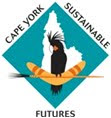This wet season has seen a number of cyclones/ tropical lows move into the Gulf of Carpenteria. These storms bring strong winds that push nets and debris onto the beaches of western Cape York. In the path of these nets are countless marine life, including many sea turtles. On Pennefather Beach alone over 60 turtles were washed up, caught in nets, over a 2 week period!!! We found a similar situation when we surveyed some of the more remote areas on northern Cape York. Because much of this coastline is innaccessible in the wet season, it is unknown what the scale of the issue is. But is is likely that hundreds to thousands of turtles die on Cape York this way each year.
The picture below shows 2 adult female flatback turtles washed up in nets on the mainland south of Crab Island. If you look carefully you will also see feral pig tracks which were preying on the helpless turtles.
Thursday, March 25, 2010
Friday, March 5, 2010
Satellite Tracking Hawksbill Turtles
A satellite transmitter was attached to a hawksbill turtle during the recent nesting study on Milman Island. This will enable us to determine the post nesting migration of this particular nesting female.The project is designed to gather an understanding of the range of movement, migration routes, habitat use and behaviour – information critical to effectively manage the population.
You can see where the hawksbill is right now by clicking on the image below:
Funding for the transmitter was provided by the Sydney Aquarium Conservation Fund, and deployed as part of the Milman Island project in collaboration with Sea Turtle Foundation and QPWS. Funding and support also kindly provided by Project Aware and Sea Swift Shipping.
Labels:
Australia,
brett leis,
cape york,
Crab island,
feral pig,
flatback,
ghost net,
indigenous,
natatory depressus,
olive ridley,
predation,
sea turtle,
sea turtle australia queensland milman
Subscribe to:
Comments (Atom)






